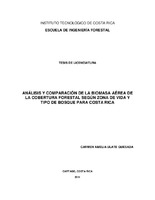Análisis y comparación de la biomasa aérea de la cobertura forestal según zona de vida y tipo de bosque para costa rica
Resumen
The management and conservation of tropical forests and climate change are related because these forests store biomass and also contribute with the reduction of the emission of green house gases. In this paper, were calculated the existing aboveground biomass in different forest types, with their respective life zone. Were performed an exhaustive search of information, which was taken from databases, thesis, permanent sample plots and forest inventory made in previous years. The average biomass by forest type, ranged from 2 t/ha for early secondary forest to 445,40 t/ha to primary forest. The variation of altitudinal belts in primary forest, was 20 t/ha for subalpine to 445,40 t/ha for the montane low. The moisture gradient in primary forests caused a variation of the aboveground biomass of 161,33 to 445,40 t/ha for dry forest and wet forest, respectively. Then, comparisons were made with existing biomass data in other places of Mesoamerica.
Descripción
Proyecto de Graduación (Licenciatura en Ingeniería Forestal). Instituto Tecnológico de Costa Rica, Escuela de Ingeniería Forestal, 2011.


